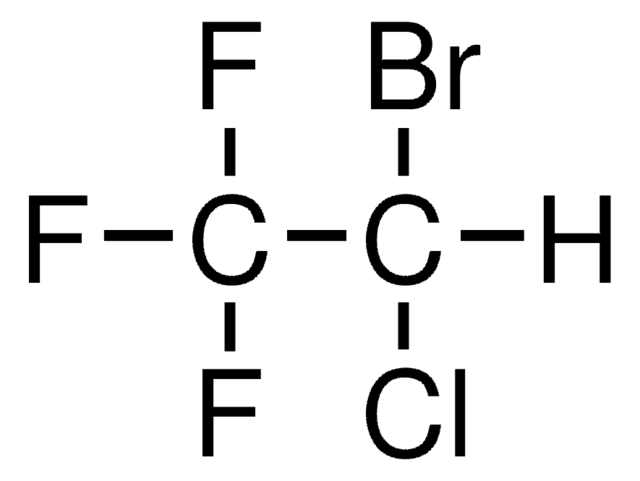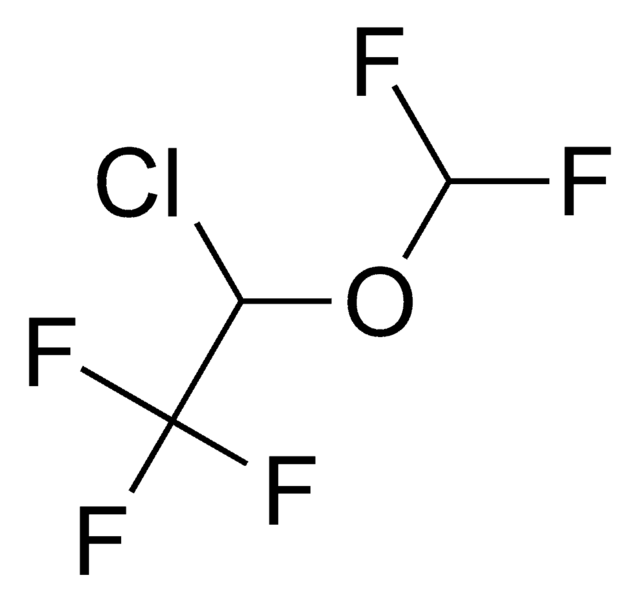おすすめの製品
蒸気圧
4.5 psi ( 20 °C)
アッセイ
≥99%
形状
liquid
含みます
0.01% thymol as stabilizer
屈折率
n20/D 1.369 (lit.)
bp
50.2 °C (lit.)
密度
1.872 g/mL at 25 °C (lit.)
SMILES記法
FC(F)(F)C(Cl)Br
InChI
1S/C2HBrClF3/c3-1(4)2(5,6)7/h1H
InChI Key
BCQZXOMGPXTTIC-UHFFFAOYSA-N
遺伝子情報
human ... ATP5D(513) , GABRA1(2554) , GABRA2(2555) , GABRA3(2556) , GABRA4(2557) , GABRA5(2558) , GABRA6(2559) , GABRB1(2560) , GABRB2(2561) , GABRB3(2562) , GABRD(2563) , GABRE(2564) , GABRG1(2565) , GABRG2(2566) , GABRG3(2567) , GABRP(2568) , GABRQ(55879) , GLRA1(2741) , GLRB(2743) , GRIA1(2890) , KCNK10(54207) , KCNK18(338567) , KCNK2(3776) , KCNK3(3777) , KCNK9(51305) , KCNN4(3783)
類似した製品をお探しですか? 訪問 製品比較ガイド
アプリケーション
生物化学的/生理学的作用
シグナルワード
Danger
危険有害性情報
危険有害性の分類
Eye Dam. 1 - Repr. 1B - Skin Irrit. 2 - STOT SE 3
ターゲットの組織
Respiratory system
保管分類コード
6.1C - Combustible acute toxic Cat.3 / toxic compounds or compounds which causing chronic effects
WGK
WGK 3
引火点(°F)
Not applicable
引火点(℃)
Not applicable
個人用保護具 (PPE)
Eyeshields, Gloves
適用法令
試験研究用途を考慮した関連法令を主に挙げております。化学物質以外については、一部の情報のみ提供しています。 製品を安全かつ合法的に使用することは、使用者の義務です。最新情報により修正される場合があります。WEBの反映には時間を要することがあるため、適宜SDSをご参照ください。
労働安全衛生法名称等を表示すべき危険物及び有害物
名称等を表示すべき危険物及び有害物
労働安全衛生法名称等を通知すべき危険物及び有害物
名称等を通知すべき危険物及び有害物
Jan Code
B4388-250ML:4548173947693
B4388-5G:
B4388-250G:
B4388-50G:
B4388-BULK:
B4388-VAR:
B4388-125ML:4548173947686
試験成績書(COA)
製品のロット番号・バッチ番号を入力して、試験成績書(COA) を検索できます。ロット番号・バッチ番号は、製品ラベルに「Lot」または「Batch」に続いて記載されています。
この製品を見ている人はこちらもチェック
ライフサイエンス、有機合成、材料科学、クロマトグラフィー、分析など、あらゆる分野の研究に経験のあるメンバーがおります。.
製品に関するお問い合わせはこちら(テクニカルサービス)











